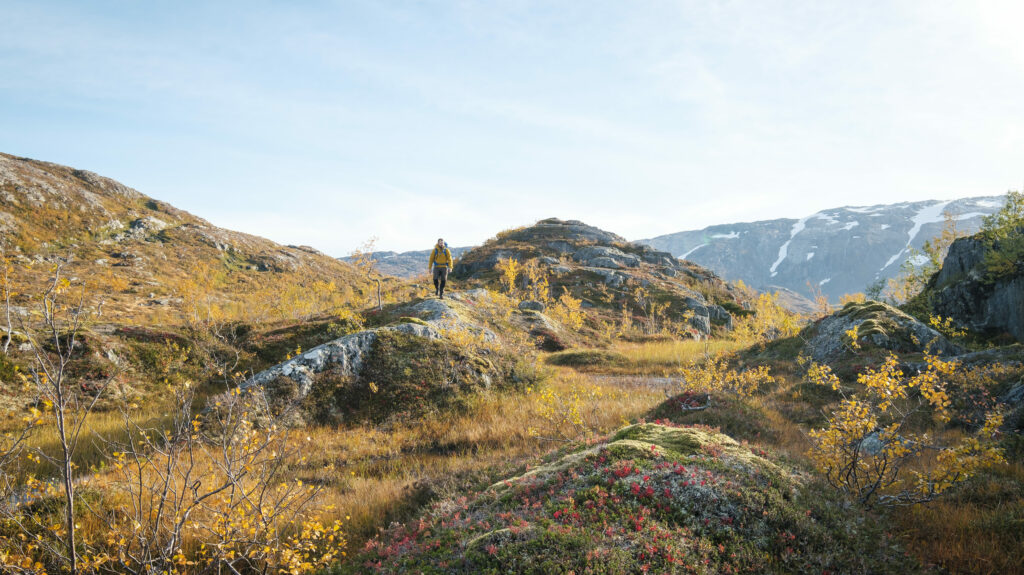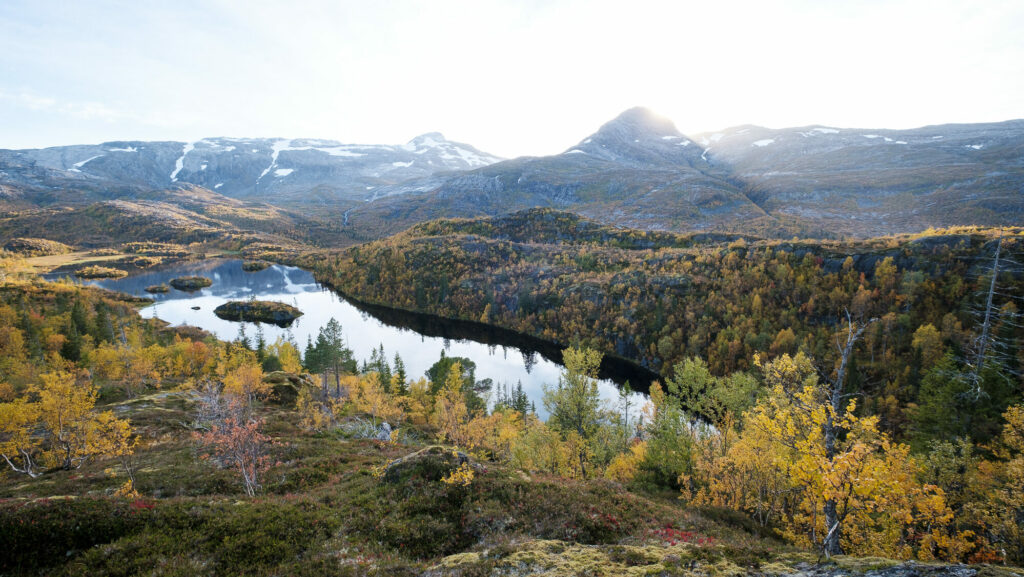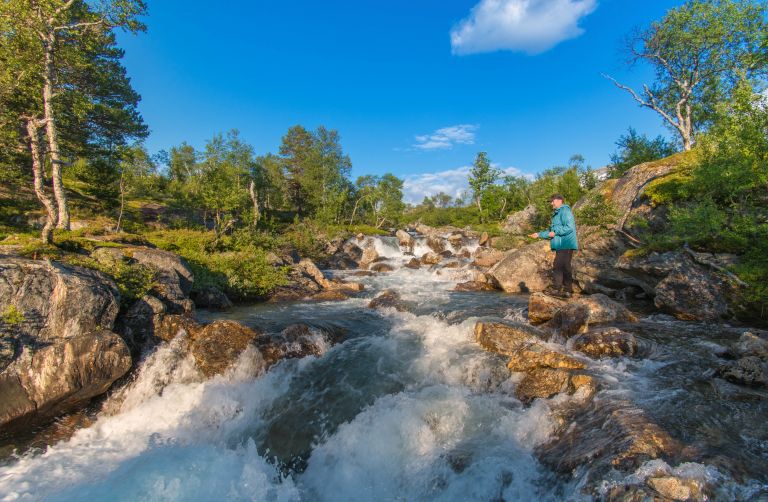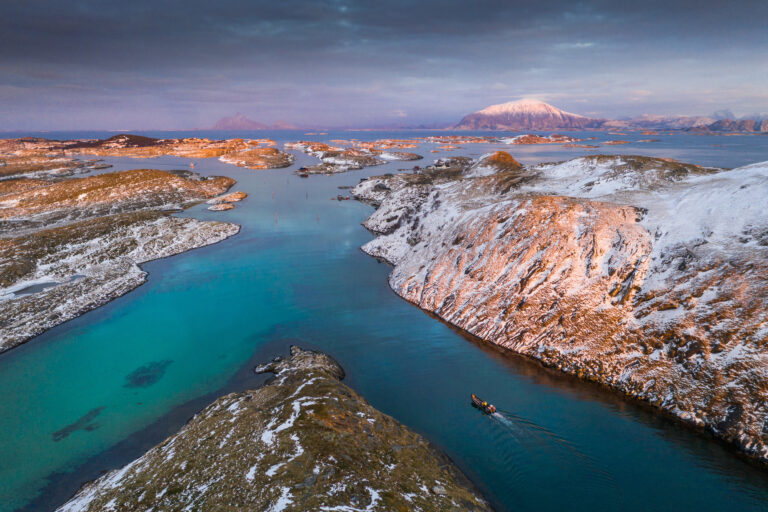Lomsdal–Visten National Park
 Kristoffer Møllevik
Kristoffer Møllevik
Lomsdal-Visten National Park (Njaarken vaarjelimmiedajve) is a hidden gem with strikingly varied landscapes. Here, you’ll find fjords, lush valleys, forests, and high mountains — and plenty of great fishing lakes throughout. There are some trails along the edges of the park, but once you reach the highlands, you’ll need to navigate on your own.
Lomsdal-Visten National Park is a vast wilderness area stretching from low-lying coastline to mountain peaks over 1,200 metres high. And when we say wilderness, we really mean it. Like Børgefjell National Park, Lomsdal-Visten has hardly any facilities. While you’ll find a few marked trails near the park’s outer areas, longer hikes require solid navigation skills and a good dose of mountain know-how.
This is also a relatively young national park, designated a national park in 2009 to “preserve a varied coastal landscape from fjord to mountain in Helgeland.” The highest peaks, Vistfjellan in the western part of the park, rise to over 1,200 metres. But there are also large areas below the tree line, where you can hike and fish with a bit more shelter from the high mountains’ unpredictable weather and wind.
The area is home to a rich and diverse range of wildlife and plant life, including wetlands, boreal rainforest, temperate broadleaf forest, mountain birch forest, and old cultivated land and grazing pastures. A varied landscape also means varied wildlife, with many birds of prey, and lynx and wolverine being the largest predators. Domesticated reindeer also graze in the park year-round.
- You are free to walk or ski anywhere, provided you don’t disturb wildlife. As the terrain can be challenging, we recommend following GPS-marked routes.
You can find GPS routes at lomsdalvisten.no. - Respect the wildlife, and be especially cautious around reindeer during calving season.
- You can bring your dog on hikes, but during the leash law period, it must be on a leash. The leash period may vary based on local regulations, so check this before you go if you are unsure. All year round, make sure your dog does not disturb wildlife such as reindeer or arctic foxes.
- You can camp almost anywhere under the right to roam (“allemannsretten”). Maintain a distance of at least 150 meters from houses and cabins, and don’t stay in the same place for more than two days.
- You can light a campfire all year, but only where there’s no clear fire risk, and in a way that leaves no marks on the terrain. Use existing fire pits, or bring a twig burner or fire bucket. Only burn fallen branches or wood you bring with you.
- You are not allowed to chop or cut down living or dead trees. Standing dead trees (snags) are especially valuable for wildlife and biodiversity and may be centuries old.
- You must not build cairns in the national park, or disturb existing ones. Established cairns serve as important navigational aids, and new ones can harm nature and the visitor experience.
- You can hunt and fish as long as you have the proper hunting and/or fishing licenses and follow the applicable regulations. Pay attention to rules for disinfecting fishing gear to prevent spreading parasites between waters.
Read more about fishing in the national park - Flying drones in the national park is not allowed. This also applies to all other motorized traffic, including e-bikes.
- Take in the natural sounds and avoid unnecessary noise. This helps protect the sensitive wildlife and ensures a pleasant experience for other visitors. Equipment such as chainsaws and motorized ice augers are not permitted in the national park.
- Make sure to bring clothing, equipment, and the skills needed for mountain conditions. The weather can change rapidly, and you can’t rely on having mobile coverage to check weather updates. You may encounter thick fog, strong winds, cold rain, or snow with little warning, even in summer. The national park is also minimally developed; you may come across rivers without bridges, glaciers, scree, and other terrain that requires the right skills and experience to pass safely.
- Be aware that it may take a long time to get help if something happens. Plan your trip carefully, considering both the weather and conditions, as well as the fitness and abilities of the entire group. Follow the Norwegian mountain safety code (fjellvettreglene) and pack clothing and gear according to the recommendations of the Norwegian Trekking Association (DNT)
Hikes and hiking areas in Lomsdal-Visten
Lomsdalen itself is often considered the heart of the national park. Combined with the neighbouring Stromp Valley and the surrounding mountains, you’ll find fishing lakes and hiking opportunities that can keep you going for days. In Stromp Valley, on the edge of the park, you’ll also find Lomsdal-Visten’s only DNT cabin — Stromdal forest cabin — a great destination for a few nights or a good backup if you’re camping.
If you’re coming from the south, for example from Brønnøysund, Bjørnstokkvatnan is an easy destination for shorter hikes or a good stop on the way to Stromp Valley and Lomsdalen.
A bit further north, for example from Sandnessjøen, the trip from Vevelstad into the beautiful Vistenfjord and the area around Innervisten is a great starting point — or destination — for your whole trip. Here, you’ll also find places to stay along the fjord, just outside the park boundary.
 Kristoffer Møllevik
Kristoffer Møllevik
If you want to enter from the east, for example from Mosjøen, the loop around Skjørlægda is a nice day hike in an area that also works well for shorter overnight trips — perfect for those who prefer not to go too far into the park. This hike starts in Eiterådalen, west of the E6 between Mosjøen and Trofors.
You’ll find more suggested hikes on the national park’s website.
Cabins and mountain farms
The Norwegian Trekking Association (DNT) has one cabin in Lomsdal-Visten — the modest Strompdal forest cabin. In addition, there are a few simple, open shelters, turf huts, and cabins where you can seek cover if needed. But for longer hikes, you’ll mostly be relying on your tent.
Entry points
There are many ways into the national park, but the easiest starting points are the five designated entrances, each with parking and information boards.
If you’re coming from the south in summer, Nevernes Havn near Brønnøysund is a good place to begin. From here, you can book a boat ride into Velfjorden — to Børjeøra if you’re heading towards Stromp Valley, or to Storbørja if you plan to follow the valleys toward Vistenfjord in Vevelstad. Outside summer, Tosbotn is a good alternative, but you might need to search a bit for suitable parking.
Further north, Forvik in Vevelstad or Tjøtta in Alstahaug (both located between Brønnøysund and Sandnessjøen) are good starting points if you want to begin your trip in Vistenfjord. From Forvik or Tjøtta, you can take the express boat to Bønå or Aursletta — both great bases for exploring Bønnådalen, Strauman Protected Landscape, and Børjedalen.
If you’re coming from Mosjøen and the E6 to the east, Eiterådalen offers the quickest access to Lomsdal-Visten. It’s a great hiking area in itself, but you can also continue across Vistfjellan to the valleys around Bønå and Aursletta in the west. That trip involves a fair bit of elevation gain and a long hike above the tree line, so you’ll need to be extra mindful of the weather — especially in autumn, winter, and spring.
Click the links to view starting points in Google Maps.
- Nevernes Havn (Brønnøy)
- Forvik and Tjøtta (Vistenfjorden)
- Eitrådalen (near the E6 between Mosjøen and Trofors)
Thank you for respecting the local communities, and for helping us preserve the natural beauty of Helgeland!
Please:
- Strive to leave no trace of your visit. Bring back all your rubbish, including used toilet paper, and discard it in the nearest rubbish bin.
- Plan your toilet visits and use the opportunity when you pass a toilet. In the wilderness, make sure you are not a nuisance to others.
- Respect the local wildlife. Keep a good distance from wildlife, livestock and birds. Keep your dog leashed.
- Respect private property. Keep a respectful distance from houses and cabins.
- Show good boating sense. Keep a good distance from shore and drive at a low speed, especially when you are close to anyone or anything on the water, including birds or animals. Avoid loud and disturbing engine noise. Be aware that some islands and nature reserves are important nesting sites, and that going ashore is prohibited during the nesting season.
- Follow the Norwegian Mountain Code (Fjellvettreglene). Plan your excursion according to the weather forecast, your skills and experience.
- Join a guided excursion or consider hiring an experienced guide, especially when you don’t have sufficient experience or knowledge to guarantee a safe trip.

